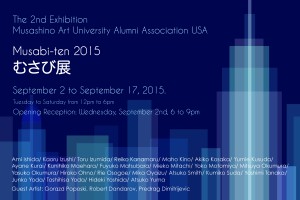Kiro Urdin – One
Opening remarks by Jane Teoharevski:
It is a special honour and real joy for me today to present you a part of Macedonia’s finest, and, at the same time, a part of the most beautiful things of today’s art creation. On his journey around the world, Kiro Urdin made a stop in New York for a fleeting moment: a painter, sculptor, director, philosopher, poet, photographer, world traveller; according to many, and without any exaggeration – one of the world’s most important cultural activists.
But, firstly allow me for all of you to make a short introduction and to try to explain briefly why what I have just said is not courtesy or exaggeration, and to explain the title of the project – One Art. Kiro Urdin is the founder of a widespread world cultural movement entitled planetarism which comprises art, film, video, photography, literature, dance and design. It all started in 1966 when he painted the first painting in human history to be worked on all over the world, from Skopje and Nerezi, the birthplace of renaissance art, to the cannibals of Mindoro, from Cheops to the Pre-Columbian sites of Machu Picchu, from the Maasai in Kenya to the Forbidden City of Beijing, from Jerusalem to the Berlin Wall, from Pompeii, Roma and Pisa, to the Suez Canal, from New York to Tokyo. The result of Kiro’s two year journey was a 48 m2 oil painting which was to be entitled Planetarium. And so, his credo – one point everywhere, everything in one point/ one art everywhere, everything in one art – was soon adopted and spread by a great number of artists around the world who recognized all the traces of this world on one canvass and further developed the art efforts to build civilization bridges between cultures. In the light of this, American choreographer Debbie Wilson stated: ‘Kiro has been inspired by other cultures which led me to envision a dance piece inspired by the themes of multiculturalism and harmony…’
For Urdin, the cosmopolite, the blend of painting and film was neither something unusual nor an effort; on the contrary, it was yet another endeavour to step further into the interpretation of life and to tell the world of its beauty, and at the same time, to scold it for wanting to destroy that beauty voluntarily or involuntarily. Nonetheless, that process opened up new questions, i.e. questions that perhaps have been long known to humankind, but now with new dimensions that can be brought by the present or modernity. In that respect, in his film from 1997 ‘Dogs and Trains’ Urdin asked: ‘What is closer to art? That which can be understood or that which cannot be done?’ He is not afraid to communicate his own scruples about our modest capacity and imperfection. On the contrary, in his films and on his canvass he juxtaposes exactly that dimension: originality, spontaneity, spirituality, timelessness and eternity, but not the fully understood categories.
The man artist does not need to travel far in order to paint his wishes and bits of imagination, and often he creates the images in his mind, but Urdin the artist wants to feel the specific. For him the journey is not literally an adventure; he wants to feel concreteness in general, the concreteness of space, of original wisdom, to feel the variety of civilizations, to touch the essence of life and of death. And what can be more disturbing, exciting and enlightening at the same time than, for instance, the wisdom of the Dogon, a mystical tribe that lives in Bandiagara, in the region of Mali: to celebrate in honour of the birth of death. Thus, a charismatic person in the film made in 2002, Nomo, warns us that everything has got a soul, even death, and that life and death live side by side, as earth and heaven.
The idea of this film from the ‘Savannah’ trilogy originates in his first film made in 1991 when young Urdin wanders the streets of Montmartre and when the Parisian vagabonds were a part of his world. Then he shot ‘Pishta’ based on the life of the charismatic vagabond of the same name whose act of setting himself on fire can be interpreted only as a celebration of the birth of death, revelation and liberation. Thus, 27 years after the first shots filmed in Paris, Urdin, the writer of films, informs us of Pishta the vagabond’s departure to heaven.
Even the seemingly meaningless plastic cups scattered on the promenade in Knokke, the city in Belgium where our artist creates in his studio – were sufficient to touch upon this subject that seems to be his favourite. Although it does not concern living creatures, the play of the cups on the pavement in ‘Steps’ brings back the travelling artist to ponder on the existence and fate in his native urban environment.
These plastic cups are chasing themselves off on the pavement up and down, to and fro, randomly, without being noticed by anyone, unlike the trains in ‘Dogs and Trains’ that pass and cross each other in a magical cyclical motion, marked in advance. Urdin marks the fateful: illusion is secret, secret is reality, and joy is illusion. Let me remind you, as he says: ‘one point everywhere, everything in one point.’
In a way that is clear and accessible to everyone Kiro Urdin observes the topic of existence in ‘Two Times’ shot in 2011 in the vicinity of Kilimanjaro where prehistoric man walked the earth 3,6 million years ago. And what is happening there now, on the savannah, after all this time of human evolution? Not an ideal image, not in the slightest: Man wants to be immortal for eternity, but that’s death for planet Earth – that is Urdin’s message.
Yet, unlike any other author, he is almost a stubborn optimist, impenitent apologist of beauty, art and life. Not as an ideologist of joy, but as a realist, an artist of flesh and blood whom planet Earth has taught to respect death equally as life. That is why perhaps he has learned in his films to gently tell us of love and friendship in the real world, as we can see that in his latest film ‘The Island of Life and Death.’ To Urdin humanness is a motive, art is a tool, while love is a message.
This last sentence is not an aphorism of the artist. In this area he has no intention whatsoever to be overly philosophical, ironic or mocking nor are his quips categorized according to an area or placed in the folder of ‘ingenious witticism of the ingenious little man’. Urdin’s aphorisms are simply spontaneous, direct and spoken in a blunt manner, although I believe many people will often gulp. Inspired by everyday life, only after reading them, we will realize that they are mere reality in which there is no exaggeration, fakery or lies; it is a reality expressed in a way that is different from conventional dialogue or discourse. And if they make you laugh, it is because that is what the artist is: he can find a silver lining even in negative things, and, above all, even though you recognize your temper in some of them, you will not feel offended. Next time you will become better, take my word for it. Urdin will make sure of it.
Thank you for your attention. And now I invite you to take a brief walk in maestro Urdin’s films.



